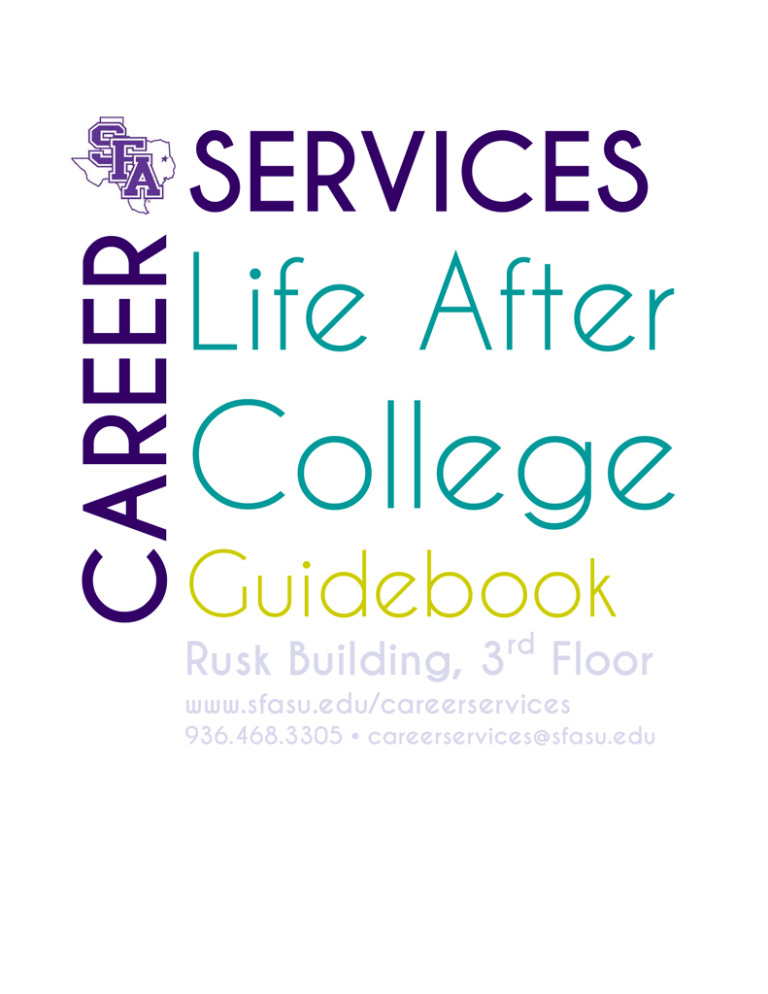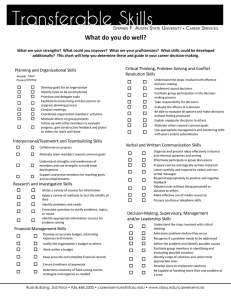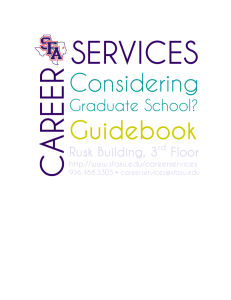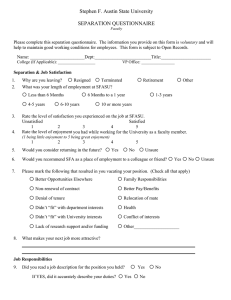College Life After
advertisement

SERVICES CAREER Life After College Guidebook rd Rusk Building, 3 Floor www.sfasu.edu/careerservices 936.468.3305 • careerservices@sfasu.edu 1. Adopt a winning attitude! Seek out those professionals within your organization that are successful and respected. Observe their attitudes, interactions with others and their work ethic. See what makes them successful and mirror their behavior. Your winning attitude should encompass characteristics of humility, respect, flexibility, confidence, a strong work ethic, the willingness to be open and learn…and a positive outlook! 2. Adjust your expectations The college to work transition is not an easy one and you may find yourself a month, a week or even a day into the job thinking “this is not what I had in mind.” Your frustration is merely the difference between expectations and reality. The truth is, many college grads express frustration in how workplace challenges are different from what they had originally anticipated. But give it a fair shot, be positive as you acclimate to your new lifestyle and try your best to keep expectations realistic. Your employer will appreciate it! 3. Learn the “rules to play by” As the newbie, you are not automatically granted acceptance, you must earn it from your colleagues. This means observing and catching on to the organization’s norm and informal rules. The best way to become accepted by your peers is by fitting in. You’ll have plenty of time to assert your own style, ideas and ways of doing things, but until you have the blessing from those around you continue to prove your value to them. 4. Manage impressions you make College vs. The World of Work College Frequent, quick, and concrete feedback (grades, and so forth) Highly structured curriculum and programs with lots of direction Few significant changes Flexible schedule Frequent breaks and time off Personal control over time, classes, interests Intellectual challenge Choose your performance level, e.g., A, B, C. Focus on your development and growth Create and explore knowledge Individual effort Right answers Independence of ideas and thinking Professors Less initiative required Work Infrequent and less precise feedback Highly unstructured environment and tasks with few directions Frequent and unexpected changes Structured schedule Limited time off Directions and interests dictated by others Organizational and people challenges A-level work required all the time Focus on getting results for the organization Get results with your knowledge Team effort Few right answers Do it the employer’s way Bosses Lots of initiative required Source: NACE Jobweb Keep in mind you have no track record, so it’s the impressions and perceptions others have of you that matter. Even the smallest blunders are magnified in impact when you’re new. Remember, what is okay for more experienced people to do may not be okay for you to do. Avoid doing anything that reminds people of college-student-type behavior. Evaluate everything you do in terms of how it will look to those who know nothing about you but who are going to put a label on you. Be safe in your first year by playing it very conservative. 5. Build effective relationships The best way to learn how to be successful in an organization is from the people! Take the time to build quality working relationships with as many people as you can. Seek a mentor, someone respected and whom you admire, listen to their advice and absorb as much information as possible. Rusk Building, 3rd Floor 936.468.3305 careerservices@sfasu.edu www.sfasu.edu/careerservices 6. Become a good follower Wait…shouldn’t that say leader? Actually, no…think about it: the typical college experience generally focuses on developing leadership skills, but you can't be a good leader until you first learn to be a good follower. Employers don't want to see your leadership skills in the beginning—they want to see your ability to follow. Your boss has quite a bit of power over your future with the organization. Cultivate a positive relationship with him or her early by becoming an easy employee to manage. After all, the boss holds the key to showcasing your talents, getting you the training that you need, shaping the organization’s opinion of you, evaluating your performance and determining your advancement beyond this position. Think long term! 7. Understand organization's culture Each organization has its own unique rules, norms, values, beliefs and atmosphere. Organizations look to hire people who fit their culture and enthusiastically embrace it when hired. Until you have a solid track record of proven performance and have been accepted as part of the team, you best not deviate from the culture! 8. Develop organizational savvy Of course every organization has formal leadership, structures, systems and procedures. But, pay close attention and take note of the informal leaders, procedures and methods that really get things done. 9. Understand your new-hire role Everyone has been the new kid on the block at one time or another, so now it’s time to pay your “new employee” dues. So what? You have to work your way up. How will you ever be in a position to manage others, unless you have done the tasks yourself? Learn your niche with the team, understand the bigger picture (you have to work your way up the ladder) and perform your tasks with a smile on your face and to the best of your ability. 10. Master the tasks in your jobs Acquire knowledge, skills, abilities you need to do your job, and to do it well. Don’t be afraid to ask your supervisor for training. You are responsible for your own personal and professional development. Seize every occasion to learn, become a master of your work and position yourself for the next opportunity. Rusk Building, 3rd Floor 936.468.3305 careerservices@sfasu.edu www.sfasu.edu/careerservices Congratulations on that new job! Before you blow your first paycheck on the hottest Apple product, get yourself in gear by developing a well-thought out budget. Doing this will ensure you won’t wind up eating beans and weenies every night, or worse…deep in debt! We know, the word “budget” brings to mind thoughts of penny-pinching, the unpleasant task of crunching numbers, and your frugal uncle Frank, but not to fret; we’ve designed a simple budget worksheet to help you track your income and expenses so you can rest easy at night! Category TAKE HOME PAY Home Utilities Food Health Transportation Debt payments Entertainment Pets Investment/Savings Miscellaneous TOTAL EXPENSES TOTAL Mortgage/rent Homeowners/renters insurance Property taxes Electricity Water/trash Telephone (land line, cell) Groceries Eating out Medical insurance Unreimbursed medical expenses (co pays) Gym Car payment (repairs) Car insurance Gas Toll tag Credit card(s) Student loan(s) Other loans(s) Cable TV/internet Hobbies Vacations Food Vet Grooming/Boarding Emergency Savings Investment Savings Clothing Toiletries/household products Grooming (hair, make-up) Dry cleaning Gifts/donations Miscellaneous expenses Monthly Budget Amount Monthly Actual Amount $ $ $ $ Tip! For expenses incurred more or less often than monthly, convert the payment to a monthly amount when developing your monthly budget. For example, if your car insurance is due once every six months, convert this premium to a monthly amount by dividing by six. This money should be kept separate from your other money so it’s available when the bill becomes due. By doing this, you will keep your spending and saving more consistent and avoid scrambling at the last minute to pay a lofty bill. Rusk Building, 3rd Floor 936.468.3305 careerservices@sfasu.edu www.sfasu.edu/careerservices Now that you’ve walked across the stage and have your diploma in hand, you may be wondering what you need to do about your student loan(s). It may not be the answer you want to hear, but the biggest mistake you can make is to procrastinate! Take the advice of your parents and start paying off your loan(s) as soon as you graduate and as quickly as possible. Get exit counseling Many loans require that you partake in exit counseling (they may even hold your transcript until completed), so be sure to contact the Financial Aid office or review their website for full details. Exit counseling provides valuable advice on how to manage your student loan payments. It answers many basic questions about student loans such as what will happen when you fail to make payments or the fact that student loans will not be excused in a bankruptcy proceeding. Know your grace period Most student loans offer a grace period of six months before you must begin repayment. Hopefully, this will allow you enough time to find your first job before you begin making those monthly payments. Important: do not assume that you are automatically granted a grace period! Contact your loan company to confirm this feature is available. Also, you should receive a letter from your company stating the date your first payment is due. If you do not receive this letter within two months or so, make contact your loan company. Communicate your new address Let your student loan company know your new address. Doing so will help them to inform you of any changes in your payment amount. Even if you have your payment directly debited from your bank account, still make sure they have your current address as you should receive tax information at the end of each year, which can save you money. Determine if you should consolidate loans Consider consolidating your student loans. Generally, this lowers your monthly payment, but more importantly it locks in your current interest rate. The rate is based on the weighted average interest rates of the loans being consolidated, rounded to the next nearest higher one-eighth of one percent, and cannot exceed 8.25%. In most cases, this can save you money. Who said education was priceless? As you pay month by month, you’ll find that you really can put a price tag on your education. We know, there are a million things you’d rather be doing with your money than repaying a loan, but in all seriousness remember your education is indispensable and now is your time to put it to good use. It may be difficult, but just try to grin and bear it as you make those monthly payments. The sooner you pay it off the better and then you can begin using that money for other things, like that beautiful handbag that’s calling your name. Problems repaying? If you have difficulty making your payments contact your loan company. As with most everything in life, communication is the key. Depending on loan type, they may be able to offer temporary or hardship deferments, which can help you avoid late fees and prevent negative marks on your credit report. So, what is a deferment? A student loan deferment allows you to temporarily stop making payments on your student loans. You may be required to continue making interest payments or you may be able to choose whether or not you pay the interest each month. The deferment will lengthen the period of time it will take you to pay off the loan as well as causing you to pay more interest on the loan, so it is important to be sure that you really need to put the loan on deferment. Rusk Building, 3rd Floor 936.468.3305 careerservices@sfasu.edu www.sfasu.edu/ccs/careerservices Money that is considered savings is often put into a low risk, interest-earning account, rather than into higher risk investments. Although there is opportunity for larger returns with certain investments, the idea behind savings is to allow the money to grow slowly with little or no associated risk. The advent of online banking has increased the variety and accessibility of savings accounts and vehicles. Here are some of the different types of accounts so you can make the most of your savings. Savings Accounts Savings accounts are offered by banks and credit unions. The money in a savings account is insured by the Federal Deposit Insurance Corporation (FDIC) up to specified limits. Certain restrictions may apply to savings accounts; for example, a service fee may be charged if more than the permitted number of monthly transactions occurs. Money in a savings account typically cannot be accessed through check-writing or ATMs. Interest rates for savings accounts are characteristically low; however, online banking does provide higher-yielding savings accounts. (Even with inflation fears, saving money is still sage advice in a recovering economy. High-Yield Bank Accounts High-yield bank accounts are a type of savings account, complete with FDIC protection, which earns a higher interest rate than a standard savings account. The reason that it earns more money is that it usually requires a larger initial deposit, and the access to the account is limited. Many banks offer this account type to valued customers who already have other accounts with the bank. Online high-yield bank accounts are available, but you will need to set up transfers from another bank to deposit or withdraw funds from the online bank. Certificates of Deposit (CDs) Certificate of Deposits (CDs) are available through most banks and credit unions. Like savings accounts, CDs are FDIC insured, but they generally offer a higher interest rate, especially with larger and/or longer deposits. The catch with a CD is that you will have to keep the money in the CD for a specified amount of time; otherwise, a penalty, such as three months' interest, will be assessed. Popular CD maturity periods are six-month, 1-year and 5-year. Any earned interest can be added to the CD if and when the CD matures and is renewed. A CD ladder allows you to stagger your investments and take advantage of higher interest rates. Money Market Funds A money market fund is a type of mutual fund that invests only in low-risk securities. As a result, money market funds are considered one of the lowest risk types of funds. Money market funds typically provide a return similar to short-term interest rates. Money market funds are not FDIC insured, and are regulated by the Securities and Exchange Commission’s (SEC) Investment Company Act of 1940. Mutual funds, brokerage firms and many banks offer money market funds. Interest rates are not guaranteed so a bit of research can help find a money market fund that has a history of good performance. Money Market Deposit Accounts Money market deposit accounts are offered by banks, and typically require a minimum initial deposit and balance, with a limited number of monthly transactions. Unlike money market funds, money market deposit Rusk Building, 3rd Floor 936.468.3305 careerservices@sfasu.edu www.sfasu.edu/careerservices accounts are FDIC insured. Penalties may be assessed if the required minimum balance is not maintained, or if the maximum number of monthly transactions is surpassed. The accounts typically offer lower interest rates than certificates of deposit, but the cash is more accessible. Treasury Bills and Notes U.S. government bills or notes, often referred to as treasuries, are backed by the full faith and credit of the U.S. government, making them one of the safest investments in the world. Treasuries are exempt from state and local taxes, and are available in different maturity lengths. Bills are sold at a discount; when the bill matures, it will be worth its full face value. The difference between the purchase price and the face value is the interest. For example, a $1,000 bill might be purchased for $990; at maturity, it will be worth the full $1000. Treasury notes, on the other hand, are issued with maturities of 2, 3, 5, 7 and 10 years, and earn a fixed-rate of interest every six months. In addition to interest, if purchased at a discount, T-notes can be cashed in for the face value at maturity. Both Treasury bills and notes are available at a minimum purchase of $100. Bonds A bond is a low-risk debt investment, similar to an I.O.U., which is issued by companies, municipalities, states and governments to fund projects. When you purchase a bond, you are lending money to one of these entities (known as the issuer). In exchange for the "loan", the bond issuer pays interest for the life of the bond, and returns the face value of the bond at maturity. Bonds are issued for a specific period at a fixed interest rate. Each of these bond types involves varying degrees of risk, as well as returns and maturity periods. In addition, penalties may be assessed for early withdrawal, commissions may be required, and depending on the type of bond, may carry additional risk, as with corporate bonds where a company could go bankrupt. The Bottom Line Savings allow individuals to squirrel away money while earning modest, low-risk returns. Due to the large variety of savings vehicles, a little research can go a long way in determining which will work hardest for you. And, since interest rates are constantly changing, it is important to do your homework before committing your money to a particular savings account, helping you make the most of your savings. Rusk Building, 3rd Floor 936.468.3305 careerservices@sfasu.edu www.sfasu.edu/careerservices Hmm…the great debate, to rent or buy. What’s the best option for you? Avoid making a rash decision; this choice must be thoughtfully made. The answer to rent vs. buy is one that hinges on your own personal circumstances. Let us help you weigh your pros and cons by providing some food for thought which can greatly help you in your decision-making process! • • • • • • • How dependable is your current job and salary level? How predictable are your other personal circumstances, such as health and marriage? How likely is it that you will want or be able to stay in the house for the next 5 years? How much travel does your job entail? If you travel frequently, will your spouse, friend or roommate be available to handle housing emergencies? How heavy is your current debt load? How well are you managing it? Do you have enough money in savings to cover a down payment and some to spare? Are you comfortable with the responsibility that comes along with owning a home? Advantages of Buying • • • • • • Mortgage interest and property taxes can be deducted from your annual tax return You build equity in your home through monthly principal payments and the property’s appreciation The profits on the sale of your home will likely not be taxed under the home ownership exclusion You won’t have to suffer rent increases (although you’ll likely pay increases in property tax, insurance and maintenance/repair costs) You will likely get more square footage living space for the money when you buy a home You can refinance whenever interest rates go down, or tap into your home equity with a loan, should you find yourself in need of money Advantages of Renting • • • • • You can pay down any debt or invest money wisely instead of forking over a large down payment You have no long-term commitment to this living arrangement You don’t have to oversee or pay for repairs or maintenance You have no obligation to find a new tenant when you are ready to leave You have no risk if housing prices in the area fall How much should I budget towards housing? Typical budgets suggest allocating between 25-35% of your income for housing expenses; this means all expenses associated with your home or apartment (not just the rent or house payment), it includes property taxes, home/renter’s insurance, homeowner’s dues, etc). For your convenience, use the table below to see what an acceptable budgeted amount would be based on your total gross income. Gross Annual Income $26,000 $28,000 $30,000 $32,000 $34,000 $36,000 $38,000 $40,000 $42,000 Housing cost per month 25% $542 $583 $625 $667 $706 $750 $792 $833 $875 30% $650 $700 $750 $800 $850 $900 $950 $1000 $1050 35% $758 $817 $875 $933 $992 $1050 $1108 $1167 $1225 Gross Annual Income $44,000 $46,000 $48,000 $50,000 $52,000 $54,000 $56,000 $58,000 $60,000 Housing cost per month 25% $917 $958 $1000 $1042 $1083 $1125 $1167 $1208 $1250 30% $1100 $1150 $1200 $1250 $1300 $1350 $1400 $1450 $1500 35% $1283 $1342 $1400 $1458 $1517 $1575 $1633 $1692 $1750 Rusk Building, 3rd Floor 936.468.3305 careerservices@sfasu.edu www.sfasu.edu/careerservices As you may or may not know, part of your duties as an American citizen includes forking over approximately 30-40% of your hard earned paycheck to Uncle Sam. Ouch! All new employees are required to fill out the W-4 form when beginning a new job; how you complete this form determines the amount of federal income tax to have withheld from your paycheck. Withholding You may want to review your withholding every year, especially after finishing your tax return. You can have more, or less, income tax withheld from your paycheck. What's a Withholding Allowance? It represents your total tax deductions divided by the personal exemption rate. The withholding allowance is related to, but not the same as, the number of dependents you can claim on your tax return. How to fill out the W-4 1. Download Form W-4 from the IRS website. This form is in a PDF format, and you can type your information on your computer before printing it out. 2. Provide your name, address, and Social Security Number. 3. Check the box for married or single, depending on your marital status. 4. Calculate how many withholding allowances to claim. For most people, this is the same as the number of personal exemptions they claim on their tax return (see Line 6d on your 1040A or 1040). 5. If you have more than one job, if your spouse works, or if you itemize your deductions, use the worksheet on Form W-4 page 2. Use this worksheet to calculate the number of allowances to claim instead of relying on your personal exemptions. 6. You can also use the IRS Withholding Calculator to calculate your withholding allowances more exactly. 7. If you have more than one job, make sure you claim zero allowances at your second job. Claiming "exempt" is NOT the same as claiming zero. If you claim zero, the highest amount of tax will be withheld. 8. If you claim more than 9 allowances, your employer may be required to send your W-4 to the IRS for review. Don't be alarmed. People with incomes over $100,000 and with substantial itemized deductions may need to claim over nine allowances. 9. You are exempt from income tax withholding only if your income for the year will be less than $800. If you are exempt, skip lines 5 and 6, and write "EXEMPT" on line 7. 10. Print, sign, and date the form. 11. Give the W-4 to your employer. They will fill out lines 8, 9, and 10. Resource: http://taxes.about.com/od/preparingyourtaxes/ht/W4.htm Rusk Building, 3rd Floor 936.468.3305 careerservices@sfasu.edu www.sfasu.edu/careerservices




